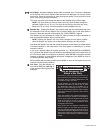
• Select - To select a Landmark already in the database, choose the "Select" option and
scroll through the list. Press ENTER to select a Landmark, then press GO TO and the tel-
escope slews to the object.
•
Add - To add a Landmark, choose the "Add" option. Enter a name for the Landmark.
Locate and center the Landmark, then press ENTER.
Identify is an exciting feature for an observer who wants to scan the night sky and start explor-
ing. After the telescope has been properly aligned, use the Autostar Arrow keys to move about
in the sky. Then follow this procedure:
IMPORTANT NOTE: Only use the Arrow keys to move the telescope during the
Identify procedure. Do not loosen the telescope locks or move the base. Alignment
is lost.
1. When a desired object is visible in the eyepiece, keep pressing MODE until the “Select
Item: Object” menu is displayed.
2. Scroll through the Object menu options until the “Object: Identify” screen appears.
3. Press ENTER. Autostar searches the database for the identity of the object being
observed.
4. If the telescope is not directly on an Autostar database object, the nearest database object
is located and displayed on the screen. Press GO TO and the telescope slews to that
object.
Event Menu
The Event menu provides access to dates and times of astronomical events. The Event data-
base includes:
Sunrise and Sunset calculates the time
that the Sun rises or sets on the current
date. Find rise and set times for other
dates by entering a new date into the
“Setup: Date” menu.
Moonrise and Moonset calculates the
time that the Moon rises or sets on the
current date. Find rise and set times for
other dates by entering a new date into
the “Setup: Date” menu.
Moon Phases displays the date and
time of the next Full, New, 1st Quarter,
and 3rd Quarter Moon.
Meteor Showers provides information
on upcoming meteor showers, such as
the Perseids, the Leonids,
etc. Also lists
the dates of the showers and when they
reach maximum.
NOTE: Meteors are fast moving
objects that cover large areas of
the sky and are usually best
observed with the naked eye.
Solar Eclipse lists upcoming Solar
Eclipses, including the date and type (total,
annular, or partial) of eclipse, and the location
and time of the first and last contacts of the
Moon's shadow. Use the Scroll Up and Down
keys to display the available data. Remember,
never use a telescope to look at the sun! See
“WARNING!” page 2.
Autostar Menus 17
TIPS
FOR BEGINNERS
• Try to pick an observing site away from street
and house lights and car headlights. While this
is not always possible, the darker the site, the
better.
• Give your eyes about ten minutes to adjust to
the darkness before observing. Give your eyes
a rest from observing every ten or fifteen min-
utes to relieve eyestrain.
• Try not to use a standard flashlight. A lot of
observers use red LED flashlights or tape red
cellophane over their flashlights to use for
setup and map reading so they don’t have to
continually readjust their eyes to the darkness.
Be careful not to shine bright lights if there are
other observers in the area. Do not shine a
flashlight into the telescope while someone is
observing!
• Dress warmly. It gets chilly when you’re sitting
for prolonged periods.
• Practice setting up your equipment during the
day or in a lighted area to become familiar with
it before going to a dark site.
• Use your 25mm eyepiece to view terrestrial
objects and wider areas of space, such as
open star clusters. Use your 9mm eyepiece
when you wish to view something up close,
such as craters on the Moon or the rings of
Saturn.
•
Know your observing site. If you’re going to try
out an unfamiliar site, check it out in the daylight
for possible obstructions and pitfalls.


















